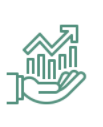American Actor, Will Rogers, once said, “You never get a second chance to make a first impression.” This is especially true for fundraisers, who bear the responsibility of representing their organization and its values.
When meeting with a prospect or donor for the first time, fundraisers need to come across as organized, pragmatic, and empathetic to cast their organization in a positive light and, hopefully, solicit a gift. If fundraisers don’t make a good first impression, they may miss out on establishing a meaningful and long lasting philanthropic relationship.
The best way to prepare for a successful first impression is to organize what you know about an individual into a prospect or donor profile. A detailed profile provides fundraisers with key talking points and the information necessary to craft an appeal tailored to their prospect’s interests and giving history.
Here are the categories you need to include in your donor profile:
- Basic Information
- Advanced Information
- Linkage Indicators
- Propensity Indicators
- Capacity Indicators
- Appeal Strategy
As I outline these categories, I’ll also describe what fundraising data you need to include and where to find all of it.
FREE Donor Profile Template for Fundraisers
Use this template to record and track important details about your donors and prospects so you can target the right individuals for the right fundraising campaigns.
1. Basic Information
The first thing you’ll need to do is record your prospects’ essential information. While “essential” could be defined in a variety of ways, you should at least include these categories:
- First & Last Name
- Home Address
- Email Address
- Phone Number
- Date of Birth
- Gender
You may also find it helpful to add a few checkboxes to this section, indicating whether an individual is a current donor or volunteer. This way, you can get a quick reminder about someone’s relationship with your organization.
Additionally, if your organization records prospect or donor’s ID, don’t forget to include them in your profiles.
To have a detailed and actionable donor profile, you need to collect information from various sources. To help get you looking in the right direction, I’ve compiled a list of paid and free resources to draw on:

Paid Research Tools
Wealth screening and prospect research tools are a must-have for any prospect researcher who wants to paint the complete picture of a prospect and save time while doing it. Tools like DonorSearch, Windfall, and iWave have massive wealth and philanthropy databases showing previous giving transactions, personal information, connections, and even contact details. Although these tools require an investment, they are worth it in the long run.

LinkedIn
Many high-net-worth prospects will have a successful career and a LinkedIn profile to show for it. LinkedIn is an excellent source for prospectors as you can see someone’s professional history, interests, connections, and a picture of them.

Federal Elections Commission
Did you know that someone who’s given at least $2,500 to a federal political campaign is 14 times more likely to give philanthropically than someone who hasn’t? It’s true! To see if your prospect has made a campaign contribution and understand their propensity to give, look them up on the Federal Election Commission.

Edgar & Yahoo Finance
To better understand a prospect’s capacity to give, you can do some research on their stock ownership. Using EDGAR, the SEC’s open access corporate database, or Yahoo Finance, which provides financial news, data, and commentary, may allow fundraisers to see if any of their prospects own a significant share of any stock.

Real Estate Listings
Once you know a prospect’s address, you can look up a previous listing for their property or properties in their area to see what their capacity to give might be. Try using Zillow to get an estimate for property value. Don’t underestimate the importance of knowing a donor’s property value! Donors who owns $2M+ worth of real estate is 17 times more likely to give philanthropically than the average person.
2. Advanced Information
After you include the basics, you can expand the profile with more specific information that’ll help you really get to know your prospect.
Here are some more advanced categories to focus on:
- Education History
- Awards
- Parental Status
- List of Children with Ages
- Marital Status
- Partner’s Name
- Social Media Profiles
- Job Title
- Company
- Other Corporate Affiliations
- Board Seats
- Secondary Email
- Secondary Phone
- Secondary Address
- Race
- Ethnicity
For advanced information, there’s no limit to the number of categories you can include. However, try to limit the information you collect to what’s most relevant to helping you with a future appeal.
3. Linkage
Somewhere in a donor or prospect profile, you should describe how the prospect is linked to your cause. This information is key to establishing if someone is likely to donate and knowing what motivates them to give.
Here are a few categories that can help you understand how a prospect is linked to your cause:
- General Volunteer History: Has a prospect previously volunteered for an organization with a similar mission? If yes, there may be a link between the donor and your mission.
- Board Membership History: If a prospect is heavily involved in the governance of a similar organization, they may be interested in supporting another organization with a similar mission.
- Philanthropic Focus Areas: When reviewing a prospect or donor’s giving and volunteer history, record the causes they most commonly gave to. If you find that they’ve given to an organization with the same cause as yours, they may be willing to make a gift. Check out Charity Navigator’s list of categories and causes to develop your own classification system.
- Past Volunteering with our Organization: If someone has previously donated their time to your organization they may be willing to make a cash gift as well.
- Donation History with our Organization: This may seem obvious, but don’t forget to see if an individual has already made a donation. If they have, this is a clear sign that they may be willing to donate again.
- Stakeholder Social Connections: If someone within your organization knows a high-value donor or prospect they may be able to help with the solicitation and stewardship process. Don’t forget to use the organization’s network to your advantage!
- Other Interests: Record any other interests an individual may have that they displayed on social media or elsewhere. Knowing someone’s interests is a great way to develop talking points.
Including these categories in a profile will help you pinpoint how an individual’s passions and interests relate to your cause.
4. Propensity
Knowing how connected someone is to your cause isn’t enough to get the complete picture of them as a prospect. Fundraisers also need to know how philanthropic an individual is.
To properly record philanthropic propensity, fundraisers should include these factors in their donor or prospect profiles:
- Most Recent Gift
- Largest Gift
- Average Gift Amount
- Number of Total Gifts
- Number of Orgs supported
- Average Annual Number of Gifts
- Most Giving Time of Year
By looking at these factors, fundraisers will understand what type of donor a specific prospect is. For example, a prospect whose last recorded donation was in 2017, has given to 5 organizations total, and has a largest gift of $900 will likely not be a star donor for your organization. However, a donor that gives 4 times a year, has given to 25 organizations total, and has a largest gift of $25,000 should be a much higher priority.
5. Capacity
Now that you’ve recorded a prospect’s linkage and propensity, it’s time to answer the big question: How much are they able to give?
There are a few ways to answer this question. By relying on wealth indicators, fundraisers can develop a reasonably accurate idea of a donor’s capacity. Consider Including these wealth indicators in your profiles:
- Political Contributions
- Real Estate Ownership
- Stock Ownership
- Boat Ownership
- Plane Ownership
- Major Gifts
- Salary Estimate
You likely won’t be able to find data to fill each of these categories. However, by filling as many as you’re able to, you’ll get a general idea of what a prospect’s capacity is and how much you should ask for on your first appeal.
6. Appeal Strategy
Ultimately, the purpose of having well-thought-out profiles is to perform more informed appeals, hopefully with higher success rates. So, the last section of a profile should outline your solicitation strategy. Focus on these items to get ready for your appeals:
A. Suggested Ask Amount: To determine what amount to ask for on your first appeal, review the previous first-time gifts a prospect has made to other organizations. Their donation history should reveal how much they’ve been comfortable giving in the past and, therefore, how much they’d be comfortable giving you. If this information isn’t available, review the first-time donations from your donors who had a similar linkage, propensity, and capacity compared to the prospect in question.
Make the Right Ask At the Right Time
You don’t have to spend hours combing through a donor’s giving history to come up with the perfect amount to ask for! With Fundraising KIT’S Smart Ask feature that analyzes every contacts’ giving history and capacity, fundraisers always know the right amount to ask for!
B. Outreach Date: To craft a well-timed appeal, review when a donor has most commonly given in the past and design your strategy to build up to that date. More importantly, make a note of this timing in the prospect’s profile for future reference.
C. Communication Method: Make sure to record a prospect’s preferred method of communication so you don’t waste time in the future by reaching out to them in ways they may find intrusive or through a medium they don’t monitor frequently.
D. Associated Impact Area: When studying a prospect’s past giving, pay close attention to the specific impact areas and campaigns they’ve contributed to. This is helpful information because you may be able to offer them an opportunity to support a similar initiative within your organization. In addition, highlighting your programs in a way that aligns more closely with their values is a great way to increase the chance of a successful fundraising appeal and the meaningfulness of their contribution.
E. Talking Points: As you monitor a prospect’s social media, previous giving, and professional profile, you’ll learn a bit more about their values and interests. Make sure to write down the areas you feel comfortable talking about in order to always have a topic of conversation up your sleeve.
F. Past Interactions: Last, keep a record of past interactions. Interactions can be things like emails, phone calls, or anytime you’ve communicated with the prospect. Writing this down will help you remember topics you’ve already covered and keep the relationship moving forward. Even better, Keela’s automated workflows allow fundraisers to steward contacts with the right messaging at the right time. Essentially, Keela can track and manage interactions at scale while also promoting interactions that drive more revenue.
Outside of these categories, you could also include a note-taking section to include insights that don’t fit well into any other categories.

Talk to a fundraising expert today to learn more about how Fundraising KIT can quickly and easily help your nonprofit raise more for your cause.
Remember, while having more information on a prospect is usually better, try to only record the details that are critical to a future appeal. Ultimately, the goal of a donor profile is to help you remember your prospect’s story and align that story with your organization. The more alignment you can find, the better you’ll be able to connect with a prospect and the more likely they will be to join you in pursuing your organization’s mission.

Jack Showers
Nonprofit Research Analyst at Fundraising KIT
When Jack isn’t cheering for the Raptors or watching an 80s action movie, he’s studying the social sector and producing content for nonprofit professionals. As a Nonprofit Research Analyst at KIT, an AI-powered insights and reporting toolkit, he is especially passionate about helping fundraisers save time and raise more money for their cause.








